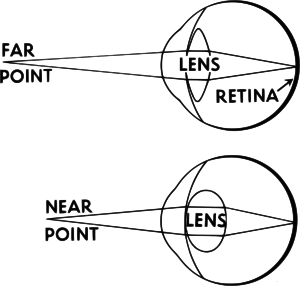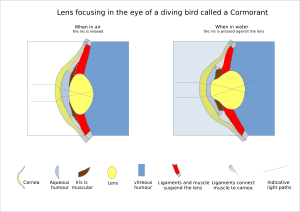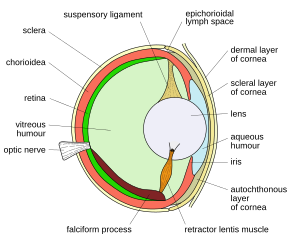Accommodation (vertebrate eye) facts for kids
Accommodation is how your eye changes its focus to see things clearly, whether they are far away or very close. It's like your eye's built-in zoom lens! This process helps you see objects sharply, from the farthest point you can see clearly (called the far point) to the closest point (called the near point).
Usually, accommodation happens automatically, like a reflex. It's part of a system that also makes your eyes turn inward and your pupils get smaller when you look at something close. But you can also try to control it a little bit if you think about it.
Animals change their focus in a few main ways:
- Changing the shape of the lens inside the eye.
- Moving the lens closer or farther from the retina (the back of the eye where images form).
- Changing the overall length of the eyeball.
- Changing the shape of the cornea (the clear front part of the eye).
Contents
How Eyes Focus Light
To see clearly, your eye needs to bend the light coming from objects. This bending of light is called refraction. The eye's cornea and lens have special curves that bend the light precisely. This creates a clear image on your retina. Because of how light works, the image that forms on your retina is actually upside down! Your brain then flips it right side up so you see the world normally.
Animals live in different places, like air or water. Light bends differently in air than in water.
- For animals that live in air (like humans, birds, and reptiles), most of the light bending happens at the front of the eye, where the air meets the cornea. The lens then does the "fine-tuning" to make the image perfectly clear. These animals usually change the shape of their flexible lens using tiny muscles called the ciliary body.
- For animals that live in water (like fish and amphibians), the cornea doesn't bend light as much because water is similar to the eye's fluid. So, their eyes need to bend light more using the internal structures. Fish and amphibians often have a harder, rounder lens that moves back and forth to change focus, rather than changing its shape.
How Land Animals Focus (Changing Lens Shape)
Most animals that live on land change the shape of their lens to focus. Scientists have studied this for a long time, but it's tricky because the lens is clear and only works properly inside a living eye.
External Forces on the Lens
The most common idea for how human eyes focus was suggested by scientists like Young and Helmholtz.
- Normally, tiny fibers called zonules hold the lens flat and stretched.
- When you look at something close, a muscle called the ciliary muscle contracts. This relaxes the tension on the zonules.
- When the tension is released, the elastic lens naturally becomes rounder and thicker. This makes it bend light more, helping you see close objects clearly.
- When you look at something far away, the ciliary muscle relaxes. This pulls the zonules tight again, flattening the lens and making it thinner. This bends light less, helping you see distant objects clearly.
Another idea, proposed by Schachar, suggests that some ligaments might pull on the lens in different ways, allowing for more precise changes in its shape, especially at the front.
Internal Forces in the Lens
Some scientists think the lens itself might play a more active role in changing its shape, not just passively responding to outside forces. The lens has special proteins that allow water to move in and out, and its different layers have slightly different ways of bending light. It's possible that changes in water movement inside the lens could help it change its focusing power.
How Human Eyes Focus
A young person's eye can change focus from very far away (like infinity) to as close as about 6.5 centimeters (about 2.5 inches) from the eye. This is a huge change in focusing power! It happens very quickly, in less than a quarter of a second.
However, as people get older, their ability to accommodate decreases. This is why many adults over 40 need reading glasses. This condition is called presbyopia. By age 45-50, most people notice it's harder to focus on close objects. By age 70, the eye can barely change its focus at all.
Theories on How Humans Focus
- Helmholtz Theory: This is the most widely accepted idea. When you look far away, the ciliary muscle relaxes, pulling the lens flat. When you look close, the muscle contracts, letting the lens become rounder.
- Schachar Theory: This idea suggests that when the ciliary muscle contracts, it actually increases tension on parts of the lens, making the center steeper and the edges flatter. This theory is not as widely accepted.
- Catenary Theory: This idea suggests that the ciliary muscle creates a pressure difference that shapes the front of the lens, similar to how a hanging chain forms a curve.
Other Eye Movements When Focusing
When you focus on something close, your eyes do two other things automatically:
- They turn inward slightly (this is called convergence).
- Your pupils (the black centers of your eyes) get smaller (this is called miosis).
These three actions (accommodation, convergence, and miosis) work together and are called the near triad. The smaller pupil helps you see things more clearly by increasing the depth of field, meaning more things stay in focus at once.
Problems with Accommodation
Sometimes, the eye's ability to accommodate doesn't work as it should. These are called accommodation anomalies. They can be grouped into two main types: when accommodation is too low, or when it's too high.
- Presbyopia: This is the most common problem. It's when your eye's lens becomes less flexible and harder with age, making it difficult to focus on close objects.
- Accommodative insufficiency: This means a person's eye can't focus as much as it should for their age. It can happen if the lens hardens too early or if the ciliary muscle is weak.
- Ill-sustained accommodation: Here, the eye can focus normally at first, but after doing a lot of close work (like reading), its focusing power gets tired and decreases.
- Paralysis of accommodation: This is when the eye's ability to focus is greatly reduced or completely gone. It can be caused by certain medicines or nerve problems.
- Unequal accommodation: This happens when one eye focuses differently than the other.
- Accommodative infacility: Also called accommodative inertia, this means it's hard for the eye to quickly switch focus from far to near, or vice versa.
- Spasm of accommodation: This is when the eye focuses too much, and the person can't control it. It can make vision blurry, sometimes making distant objects look blurry as if the person is nearsighted.
- Accommodative excess: This means a person uses more focusing power than needed for close work, or they have trouble relaxing their focus.
How Aquatic Animals Focus
Animals that live in water have different ways of focusing. Some animals, like certain whales and seals, can see well both above and below water. They might have special areas in their retina for each environment.
- In reptiles and birds, the ciliary body not only supports the lens but also has pads that press on the lens to change its shape.
- In vision in fish and amphibians, the lens usually stays the same shape. Instead, a muscle moves the lens forward or backward inside the eye to change focus. For example, in teleost fish, a muscle pulls the lens backward to focus on distant objects.
- The simplest vertebrates, like lampreys, don't have their lens attached to the eyeball. They flatten their cornea and push the lens backward to focus.
Even though mollusc eyes (like those of squids) look similar to vertebrate eyes, they work differently. They have a two-part lens and no cornea. But all eyes with lenses need to bend light to focus, so they often end up looking similar on the outside.
See Also
 In Spanish: Acomodación (ojo) para niños
In Spanish: Acomodación (ojo) para niños
Disorders of and relating to accommodation
- Accommodative esotropia (a type of crossed eye)
- Latent hyperopia (hidden farsightedness)
- Myopia (nearsightedness)
- Pseudomyopia (false nearsightedness)
Other
- Accommodation in fish
- Adaptation (eye)
- Amplitude of accommodation (how much your eye can focus)
- Cycloplegia (paralysis of accommodation)
- Cyclospasm (spasm of accommodation)
- Edinger-Westphal nucleus (part of the brain controlling eye movements)
- Mandelbaum Effect
- Negative relative accommodation
- Positive relative accommodation
Images for kids








